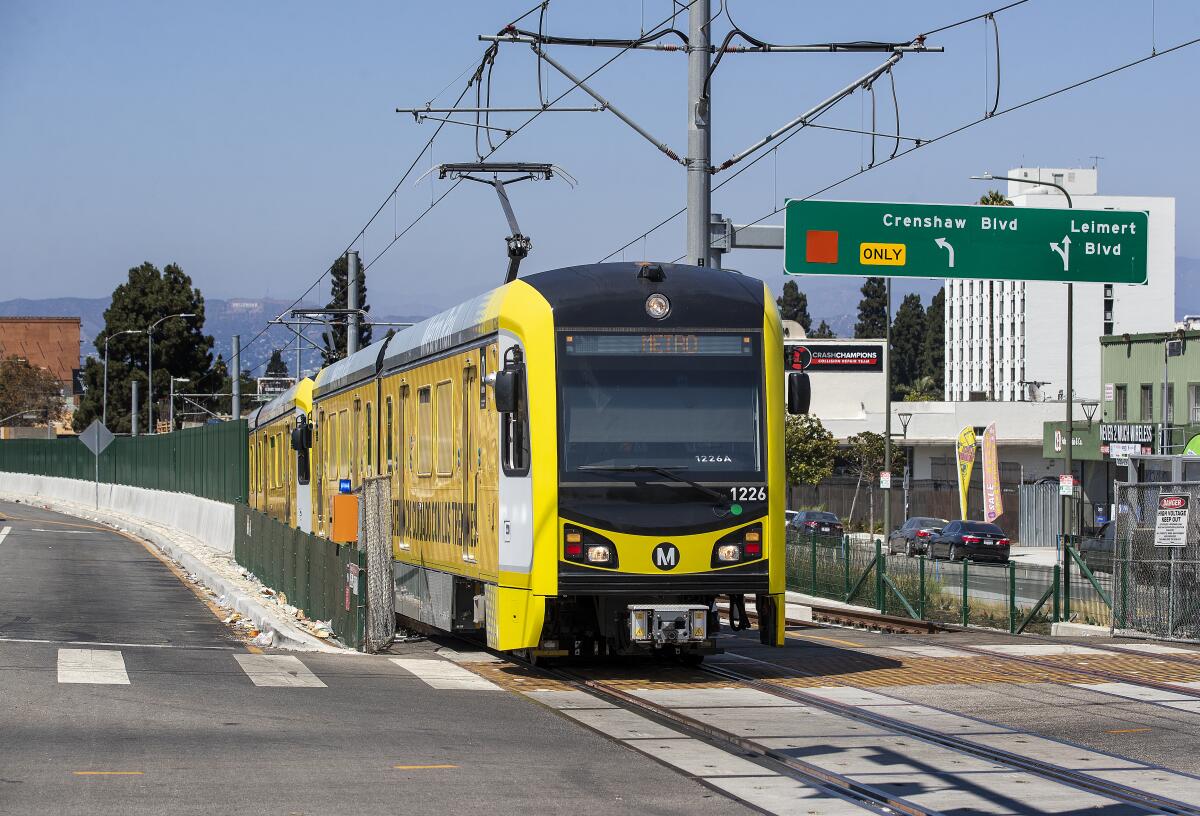Inglewood people mover gets $1-billion commitment from federal officials

Federal officials have pledged up to $1 billion for an elevated train connecting SoFi Stadium and other venues to the K Line, marking a major milestone for a marquee project that could open ahead of the 2028 Olympic Games.
The Federal Transit Administration commitment would finance half of the project’s $2-billion price tag.
For the record:
7:50 p.m. Jan. 8, 2024A previous version of this article misidentified the K Line as the Crenshaw Line.
To lock down the award, the city of Inglewood and the Metropolitan Transportation Authority must clear several more hurdles, including securing the other half of the money and making substantial progress to prepare the project for construction.
“It’s going to improve the fan experience,” said Inglewood Mayor James Butts, who has championed the project. “Fans, our residents and the employees deserve affordable and efficient transit options. This system will be good for the environment. It will again create jobs.”
Known as the Inglewood Transit Connector, the fully automated three-stop people mover will roll through Inglewood’s downtown and ferry fans to the city’s growing list of entertainment venues, which include the Kia Forum and the soon-to-be opened Inuit Dome. It’s expected to ease traffic during major events.
The city and Metro, which together form the project’s joint powers authority, say they have secured about 85% of the total $2-billion tab, counting the federal commitment. Although that commitment is not finalized, officials say it signals the viability of an ambitious project they aim to open before the 2028 Olympic Games.
“This federal support is a force multiplier on our momentum and an endorsement of all levels of government working together to benefit the public. We will get the next step done,” said Lisa Trifiletti, who is overseeing the project for the authority.
And although officials hope the people mover will be running by 2028, Federal Transit Administration documents show that it isn’t expected to open until 2030 and will cost $33 million a year to operate.
If the connector does open in time for the Olympics, Inglewood, a city of about 104,000, would be center stage, starting with the opening ceremonies at SoFi Stadium. Transit officials plan on creating a car-free Olympics and have been using events at SoFi, including Taylor Swift’s Eras tour, as a testing ground for not only the Olympics but how to deal with changing ridership patterns.
Backers say the elevated people mover and the tourists it brings will also help revitalize downtown Inglewood. But dozens of business will be forced to relocate to make room for it. And transportation experts question whether the people mover, which has increased in price by more than half a billion dollars over the last few years, is worth the cost and will deliver on its promises.
On a busy weekday, hundreds come through the door of Fiesta Martin Bar & Grill at Florence Avenue and Market Street. Esaul Martin, who runs the downtown Inglewood restaurant with his sister, is among those who will be forced to relocate.
“We don’t have a choice in what to do,” he said. The outside patio is teeming on weekends, and he has a steady local clientele.
Though his family owns several restaurants in town, he said, this is the most successful.
“Most people aren’t happy about it,” Martin said about other businesses nearby. “The options that they are giving us doesn’t come close. Either it doesn’t have parking, it’s too small, or the rent is four times this.”
Martin has hired a lawyer. But, he said, no relocation fee can replicate what he has created here. And he worries about his 45 employees.
Butts said change is hard, but the relocation packages are generous.
“This is major progress in the evolution of the city. Things are not going to be the way they are,” he said. “The benefits of this project far outweigh the angst of displacement, because everyone in Inglewood wins.”
Transit experts say the other big winners are people like Rams owner Stan Kroenke.
The $5-billion SoFi Stadium, home to the Rams and Chargers, opened in 2020. It had bypassed the lengthy environmental review process typically required in California, which would have quantified the traffic, pollution and noise that would come with a 70,000-seat stadium. Often, the developer must mitigate those impacts.
Instead, the project was approved six weeks after it was announced.
“There is definitely a good case to be made that at least there should be some financial contribution from the stadium owners,” said Jacob Wasserman, a research project manager at UCLA Institute of Transportation Studies. “It is going to serve the customers there who pay money to go see events and games. All transit serves businesses, and it’s a public service, but I think that this is disproportionately focused on these event venues.”
Butts said providing transportation is the job of municipalities.
The authority estimates that the people mover will have 4 million boardings in 2028 and nearly 8 million by 2078, which Wasserman said is likely overly optimistic.
Environmental studies show regular weekdays will be much quieter, bringing 414 passengers during peak hours and carrying 11,450 riders the hour after games.
Three pre-qualified teams are now preparing bids for the project, and the authority expects to choose one this summer.
Is it worth it?
James Moore, founding director of the USC Transportation Engineering Program, said it probably isn’t. He pointed to the half billion dollars it cost to connect the Oakland Airport to BART, which, he said, ended up having no measurable effect on either airport traffic or BART ridership.
“The bus was doing just fine,” he said. “If the goal is to connect riders from the event generator to the rail line, this is an expensive way to do it.”
More to Read
Sign up for Essential California
The most important California stories and recommendations in your inbox every morning.
You may occasionally receive promotional content from the Los Angeles Times.











